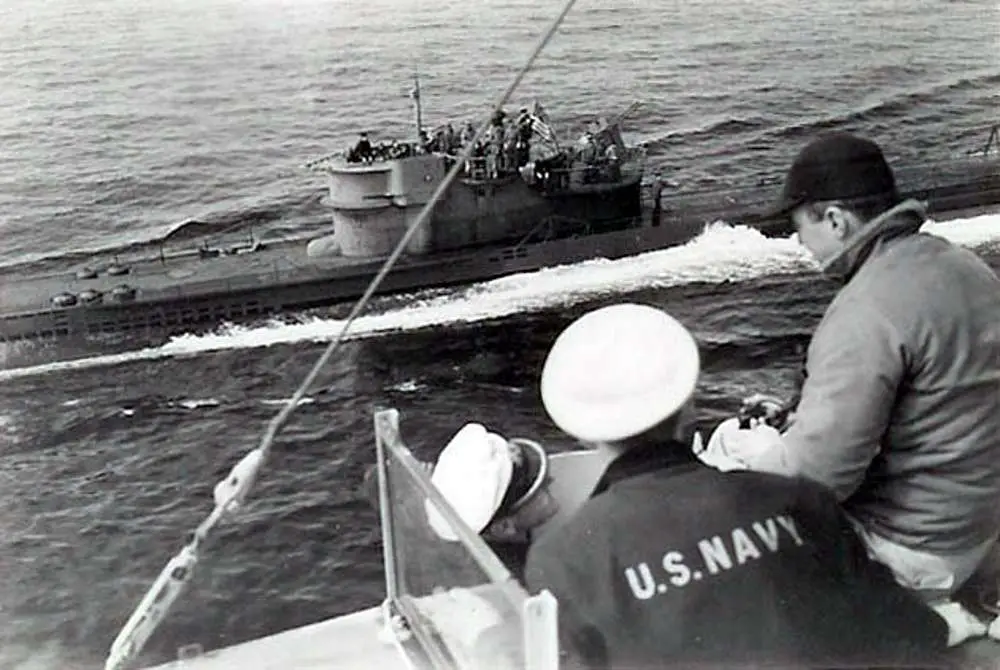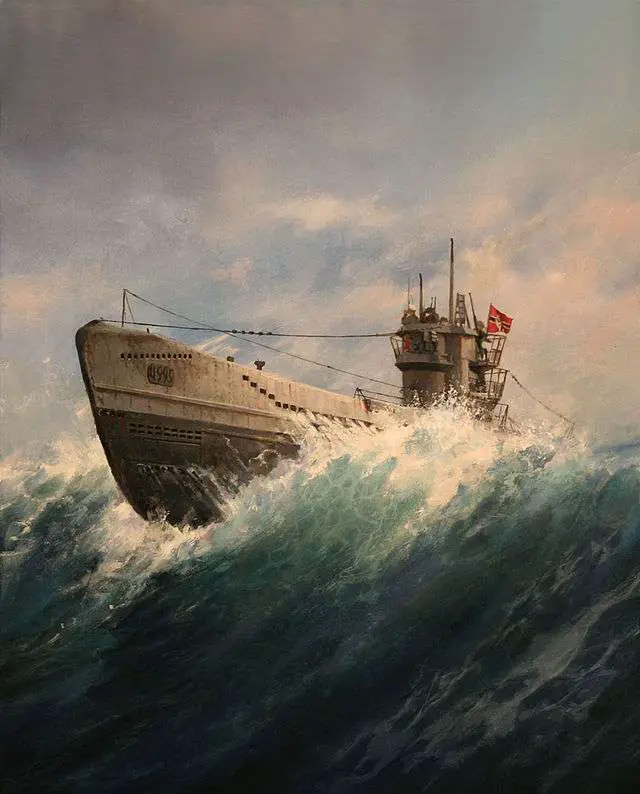On May 15, 1945, onlookers tried to glimpse the first of four Nazi U-boats towed up the Piscataqua River to surrender at the Portsmouth Naval Shipyard. The news media then went into a feeding frenzy.

U-234 surrendering to the USS Sutton.
Germany had surrendered to the Allies on May 7, 1945, bringing World War II closer to an end.
The excitement over the tangible evidence of U.S. victory increased as three more Nazi U-boats followed over the next five days. The shipyard then studied the technologically advanced Nazi subs and their cargo.
The Nazi U-boats
The U-boats, sophisticated and much-feared maritime predators, traveled together in wolf packs to sink their targets. They attacked commercial shipping in order to starve the Allies of supplies. At first they had remarkable success, sinking about 3,000 vessels, mostly merchant ships. They also killed more than 5,000 seamen and passengers.
More people died in attacks by Nazi U-boats than at Pearl Harbor.
“The only thing that really frightened me during the war was the U-boat peril,” wrote British Prime Minister Winston Churchill.
Eventually the U-boat menace subsided by 1942 when the U.S. entered the war and developed effective anti-submarine measures. But their fearful reputation persisted, contributing to the drama on the Piscataqua River in May 1945.
Fangs Yanked Out
The 245-foot U-805 was the first to arrive. She had surrendered in the North Atlantic and was towed into Portsmouth Harbor. Green dye marked the spot for the rendezvous with a tugboat carrying Navy officials and news reporters.
Three ‘surly, expressionless’ German officers appeared on board. They officially surrendered at 4:25 p.m. at the mouth of the harbor. The submarine was then taken to the shipyard for publicity photos. One caption read, “Its fangs yanked out, this prize U-boat will prey no more upon Allied shipping in the Atlantic.”
A bus took the prisoners to Portsmouth Naval Prison, commonly known as The Castle, where Office of Naval Intelligence interpreters interrogated them. They wanted technical details about jet aircraft, ballistic missile, guided bomb and nuclear weapons technology.
WHEB-AM reporter Charlie Gray scored an interview with a captain of one of the U-boats. He described Lt. Albert Finster as a ‘typical dyed-in-the-wool Nazi.’ Finster’s interview caused a stir because he blamed England for the war. He also said Allied bombing ruined his native town of Hamburg.
Two more Nazi U-boats arrived the next day: At 2 pm, U-873 was towed into the harbor, followed by U-1228. That night, a wire service report added to the excitement. The USS Sutton captured a U-boat near Newfoundland with three high-ranking German officials and two dead Japanese scientists aboard.
The Biggest Prize
On Friday, May 18, the public eagerly awaited the arrival of the fourth and last of the Nazi U-boats. Rumors circulated about its cargo. The submarine was headed to Japan, which was still in the war. Supposedly it carried personnel and materiel to help the Japanese war effort.
U-234 arrived in Portsmouth at 7:30 am on Saturday, May 19, greeted by swarms of journalists. The biggest prize of all the Nazi U-boats, the high-ranking officers aboard made it a major news story.
The submarine carried a disassembled Messerschmitt Me 262 jet fighter, prototypes, technical descriptions of new weapons and several senior weapons technicians. The two Japanese scientists were not on board. They had committed suicide by taking an overdose of sleeping pills, and the Germans buried them at sea.
The U.S. government kept the secret about part of U-234’s cargo: 1,232 lbs. of uranium oxide. Scientists later used it in the Manhattan Project for the Little Boy atomic bomb dropped on Hiroshima.
German General Ulrich Kessler, assigned as the Luftwaffe liaison in Tokyo, made an impression as the stereotypical Nazi general. Tall and formal, he wore white gloves, a long leather greatcoat, polished leather boots and an Iron Cross around his neck. He seemed to enjoy the publicity, noted WHEB’s Gray.
Kessler spoke in fluent English with a British accent. When asked how he felt about surrendering, he said, “I was in the last World War. I’ve been through it before. I’ll probably go through it again.”
The Dark Side of the Story
The Germans complained of their treatment. A subsequent investigation by the U.S. Navy confirmed their abuse. Navy prize crews seized the possessions of the Nazi U-boat crews and saved them as souvenirs. They also distributed them to local boys in small boats as the Nazi U-boats made their way up the Piscataqua. Or they stockpiled them at the prison, where corrections officers looted and sold them.
Among those items taken: pep pills, revolvers, canned goods, parts of German uniforms and decorations. Under the Geneva Convention, the U.S. should have returned the prisoners’ property.
After the crewmen of U-873 were interrogated in Portsmouth, they were then taken to the Charles Street Jail in Boston. There, they awaited transfer to a prisoner-of-war camp in Mississippi. As military officers marched them through the streets in handcuffs, crowds pelted them with garbage and insults.
Their commanding officer, Friedrich Steinhoff, returned to his cell with his face bloody and swollen. An ONI interrogator had ordered a big, strong Marine to beat him. Steinhoff bled to death in his cell, possibly from slashing his wrists with his broken glasses.
Ironically, he had a brother, Ernst Steinhoff, a rocket scientist. Ernst Steinhoff also surrendered and helped the United States with its rocketry program.
Fate of the Nazi U-boats
The U.S. Navy then took U-805 on several ‘Victory Visits’ to ports on the U.S. East Coast before sinking her.
U-1228 was then sunk in 1946, and U-234 was torpedoed off the Cape Cod coast in 1947.
Finally, in 1948, U-873 was scrapped.
With thanks to SeacoastNH.com. This story about the surrender of Nazi U-boats was updated in 2023.

